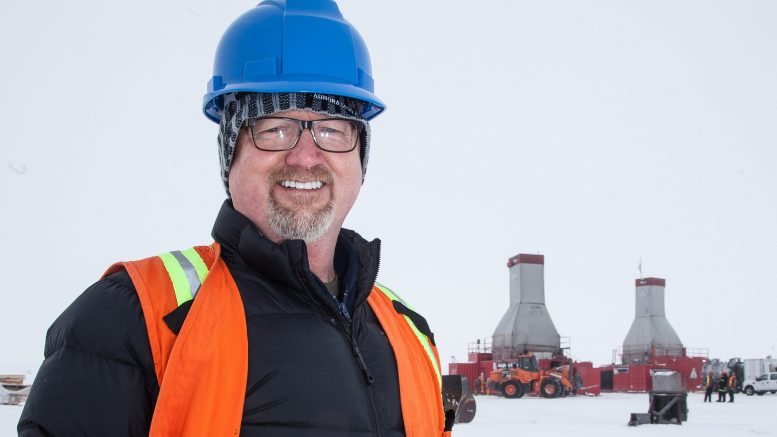KELVIN CAMP, NORTHWEST TERRITORIES — Kennady Diamonds (TSXV: KDI) has already tripled early targets at Kennady North, Canada’s most advanced diamond exploration project — and there’s an eagerness to get going and find more, says president and CEO Rory Moore.
The results of $85 million in spending and four years of determined, methodical exploration have to date probed four kimberlite pipes, labelled Kelvin and Faraday 1, 2 and 3. By year end, the company is aiming to have indicated and inferred resources totaling 20 million carats at grades north of 1.5 carats per tonne at Kennady North, located in the Northwest Territories.
Kennady’s maiden resource statement released in December 2016 outlined an indicated resource of 8.5 million tonnes grading 1.6 carats per tonne totalling 13.62 million carats in the Kelvin body alone.
“This year our mission is to get Faraday into an inferred resource,” said Moore, who joined Kennady a year ago.
“We want to evaluate those bodies and put a ribbon on them, and move on to the next. But what we are anxious to do is let loose on the exploration because there’s so much potential.”
Victims of success
On a site visit in late March, 2017, in the cozy Weatherhaven tent that houses Kennady’s Kelvin Camp geochem lab, Moore and Gary Vivian, a senior partner with Yellowknife-based Aurora Geosciences, expanded on where the program is to date.
“We believe there could be an inferred resource north of 5 million carats in Faraday,” said Vivian, whose company manages the overall project for Kennady. “I think we’ve just started to scratch the potential of the corridor. . . We think there’s more Kelvins and Faradays to be found.”
From its start as a spinoff of Mountain Province Diamonds (TSX: MPVD; NASDAQ: MPVD) in 2012, Kennady’s vision was to prove a resource of five to eight million tonnes of ore at viable grades.
Faraday’s three bodies have yet to be fully assessed, but microdiamond results to date have yielded indicative grades of between 2.18 and 3.61 carats per tonne. This compares very favourably with the find that launched the neighbouring Gahcho Kué mine, which went into commercial production this March.
It’s been hard to strike a spending balance between exploration and evaluation, said Moore.
“It’s been a challenge because we’re victims of success. As soon as you find something of significance, it’s almost impossible not to get all the drills to concentrate on that. The intention has always been to put some resources into exploration, and the majority into evaluation.”
Kennady’s 672-sq.-km claim blocks surround the Gahcho Kué property on three sides, linked by 10 km connecting it with the main ice road to Gahcho Kué. The 60-person Kelvin Camp has easy access to both the Kelvin and Faraday sites, where over the past three years, Whitehorse-based Midnight Sun Drilling has extracted 1,665 tonnes of kimberlite for bulk sampling.
Good catch
Three decades ago, Moore was a freshly-minted geochemist with a doctorate from his homeland University of Cape Town, South Africa. His first job was analyzing kimberlite for an eccentric geologist named Chuck Fipke in a garage in Kelowna, B.C. His work, during the frenzied months of 1989, helped crack the discovery of what has become the mammoth Ekati project.
“We were drilling left, right and centre and as a young exploration geologist I thought, well, this is easy,” recalls Moore, who managed the Ekati exploration program for five more years.
“I didn’t know how blessed I was to be on a winner project. It was fantastic, marvelous.”
When the Kennady board chose Moore as its top executive last May, the ambitious Toronto-based junior made a good catch.
It replaced his predecessor and Kennady’s founder, the astute mine-maker Patrick Evans, with another veteran of the Canadian diamond industry.
Moore, who had no previous connection to Kennady Diamonds, took over from Evans in a series of strategic moves by Mountain Province, just as Gahcho Kué was coming on stream. Evans had guided that program for almost 20 years, bringing De Beers in as managing (and 51%) partner, and needed to focus solely on Mountain Province.
Kennady emerged back in 2012, when Evans put together a plan to move on neighbouring diamond-bearing ground just 10 km north of Gahcho Kué. De Beers at the time was focused on mine development, but Evans, convinced the ground shared Gahcho Kué’s geological trend, lead the charge for Mountain Province to spin off Kennady as its exploration arm.
In mid-March of this year, Kennady was approached by “interested parties” regarding a potential strategic transaction.
Those parties have not been disclosed, and Kennady’s board struck a special committee to evaluate the situation, stressing that no formal offers had been received and no agreement reached. It has remained tight-lipped since releasing that information on Mar. 17.
Bill Braden is a freelance writer and photographer based in Yellowknife.
This story originally appeared in the June 2017 issue of Diamonds in Canada.


Be the first to comment on "Kennady eager to build on proven potential"